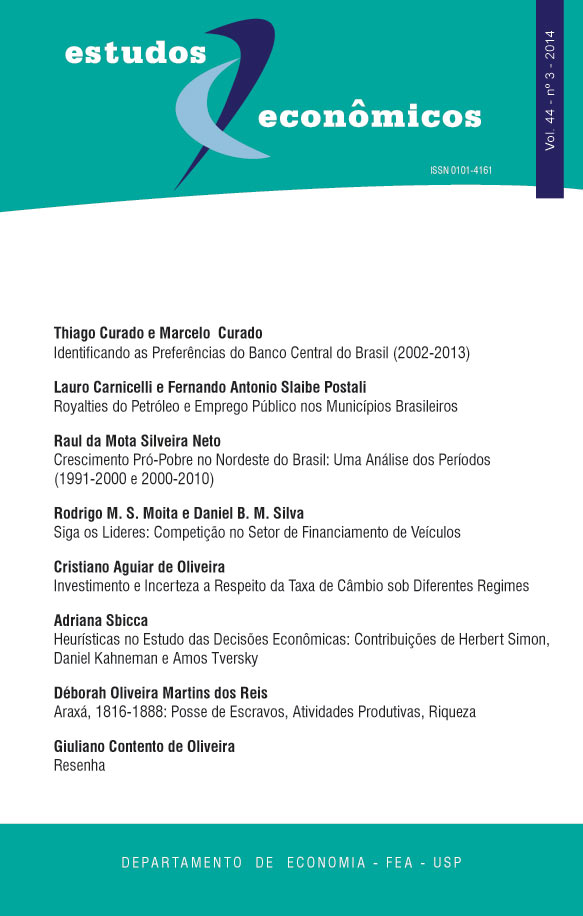Crescimento pró-pobre no Nordeste do Brasil: uma análise dos períodos (1991-2000 e 2000-2010)
DOI:
https://doi.org/10.1590/S0101-41612014000300003Palavras-chave:
crescimento, pobreza, pró-pobre, Nordeste.Resumo
Este trabalho examina o crescimento econômico na região Nordeste do Brasil no período 1991-2010 investigando, especificamente, em que medida a dinâmica da renda desta região tem sido relativamente mais favorável aos indivíduos mais pobres desta região, até o presente, residência de mais da metade das pessoas em situação de extrema pobreza no país. A partir de um indicador que considera tanto a redução da extrema pobreza, como o crescimento relativo da renda das pessoas nesta condição, os resultados são analisados para os estados da região e suas mesorregiões, considerando-se tanto a renda total, como a renda do trabalho. As evidências obtidas indicam que os períodos 1991-2000 e 2000-2010 são bastante diferentes com respeito à natureza do crescimento da renda total. Quando o foco é na dinâmica da renda do trabalho, tal distinção entre os períodos é substantivamente menor.
Downloads
Referências
AGOSTINI, C.; BROWN, P. (2011) “Cash Transfers and Poverty Reduction in Chile,” Journal of
Regional Science, 51(3), 604–625.
BARROS, R. P. et al. (2006) A queda recente da desigualdade de renda no Brasil. In: Barros, R. P.; Foguel, M. N.; Ulyssea, G. (Eds.). Desigualdade de renda no Brasil: uma analise da queda recente. Brasília: Ipea, v. 1.
CORSUEIL, C.H; FOGUEL, M. (2002) Uma Sugestão de Deflatores para as Renda a Partir de Algumas Pesquisas Domiciliares do IBGE, Texto para Discussão 878, Rio de Janeiro: Ipea.DATT, G.; RAVALLION, M. (1992) “Growth and redistribution components of changes in poverty measures: a decomposition with applications to Brazil and India in the 1980s”, Journal of Development Economics, 38, 275-295.
FOSTER, J.; GREER, J.; THORBECKE, E. (1984) “A class of decomposable measures”. Econometrica, 52 (3), 761-766.
HOFFMANN, R. (2006). “Transferências de renda e a redução da desigualdade no Brasil e cinco regiões entre 1997 e 2004, Econômica, 8(1), 55–81.
HOFFMANN, R.; NEY, M. G. (2008) A recente queda da desigualdade de renda no Brasil: analise
de dados da PNAD, do Censo Demográfico e das Contas Nacionais. Econômica, 10(1), 7-39,.
KAKWANI, N. (2000) “On Measuring Growth and Inequality Components of Poverty with application to Thailand”, Journal of Quantitative Economics , 16(1), 67-79.
KAKWANI, N.; PERNIA, E. (2000) “What is pro-poor growth?”, Asian Development Review,16(1), 1-22.
KAKWANI, N.; KHANDKER, S.; SON, H. (2004) “Pro-poor growth: concepts and measurements
with countries case studies”, International Poverty Centre, Working Paper number 1, August.
KLASEN, S. (2005). “Economics growth and poverty reduction: measurement and policy issues”, paper of POVNET for Work Program on Pro Poor Growth.
LOPEZ, J.H. (2004) “Pro-poor growth: a review of what we know (and of what we don’t)” World
Bank’s PREM Poverty Group.
MANSO, C. A.; PEREIRA, D. J. S.; BARRETO, F. A. (2008) “Crescimento pró-pobre: diferenças de
intensidade entre rural e urbano no período 2002-2005”, Revista Econômica do Nordeste, 39(4), 365-385.
OSÓRIO, R. G.; SOUZA, P. H. G. F. (2012) Evolução da pobreza extrema e da desigualdade de renda na Bahia: 1995 a 2009. Brasília: Ipea (Texto para Discussão, 1696).
PARTRIDGE, M.; RICKMAN, D. (2006). The Geography of American Poverty: Is There a Need for
Place-Based Policies? Michigan: W. E. Upjohn Institute for Employment Research.
RAVALLION, M (2004) “Pro-poor growth: A Primer”, Policy Research Working Papers n. 3242,
World Bank.
RAVALLION, M.; CHEN, S. (2003) “Measuring pro-poor growth”, Economic Letters, 78, 93-99.
ROCHA, S. (2003) “Pobreza no Nordeste: a década de 1990 vista de perto”, Revista Econômica do Nordeste, 34 (1), 7-41.
SEN, A. (1999) Development as Freedom, Oxford: Oxford University Press.
SILVEIRA NETO, R. M. (2005) “Quão pró-pobre tem sido o crescimento econômico no Nordeste do Brasil? Evidências para o período 1991-2000”, Revista Econômica do Nordeste, 36(4), 483-507.
SILVEIRA NETO, R. M.; AZZONI, C. R. (2012) Social policy as regional policy: market and non-market factors determining regional inequality. Journal of Regional Science, 51, 1-18.
SOARES, S. (2006) Analise de bem-estar e decomposição por fatores da queda na desigualdade entre1995 e 2004. Econômica, 8(1), 83-115.
SOUZA, P. H. G. F. (2013) As causas imediatas do crescimento da renda, da redução da desigualdade e da queda da extrema pobreza na Bahia, no Nordeste e no Brasil entre 2003 e 2011. Brasília: Ipea (Texto para Discussão 1816).
WHITE, H.; ANDERSON, A. (2000)”Growth vs redistribution: Does the pattern of growth matter?”, DFID white paper on eliminating World Poverty: making globalization Work for the Poor.
VILLASENOR, J.A.; ARNOLD, B.C. (1989) “Elliptical Lorenz Curves”, Journal of Econometrics,
, 327-338.
Downloads
Publicado
Edição
Seção
Licença
Copyright (c) 2014 Raul da Mota Silveira Neto

Este trabalho está licenciado sob uma licença Creative Commons Attribution-NonCommercial 4.0 International License.
A submissão de artigo autoriza sua publicação e implica o compromisso de que o mesmo material não esteja sendo submetido a outro periódico.
A revista não paga direitos autorais aos autores dos artigos publicados.





 Atualizado em 14/08/2025
Atualizado em 14/08/2025